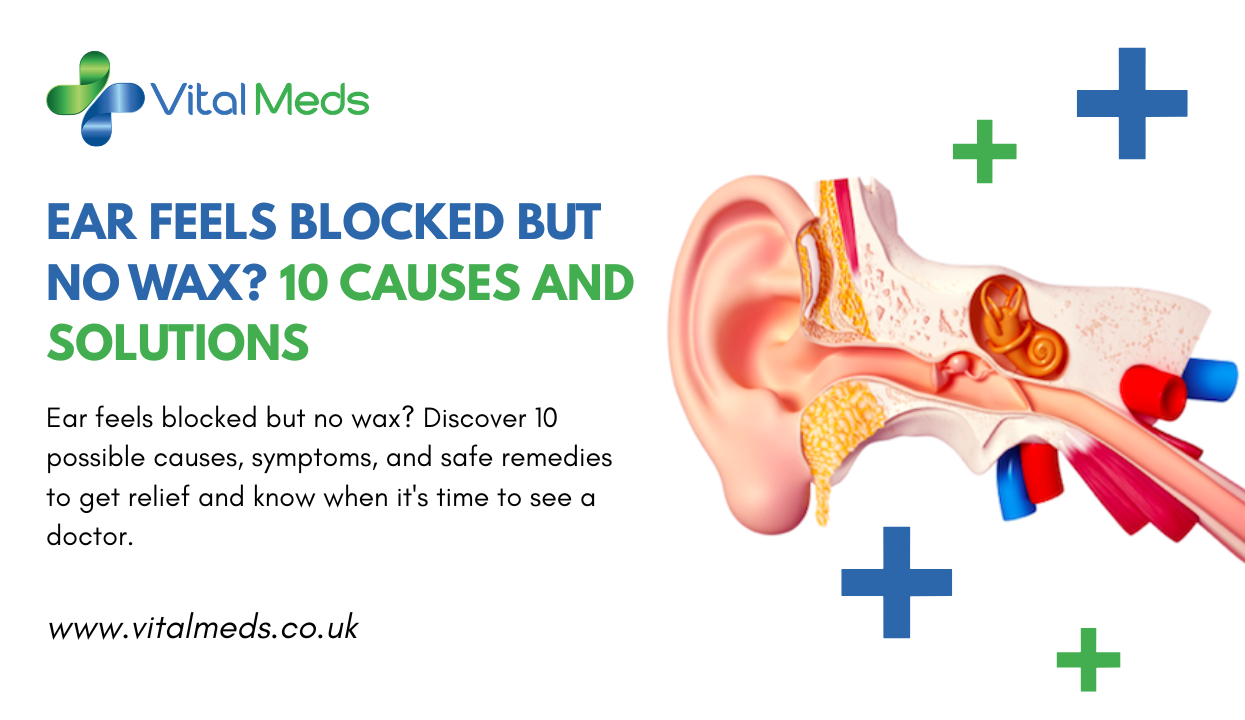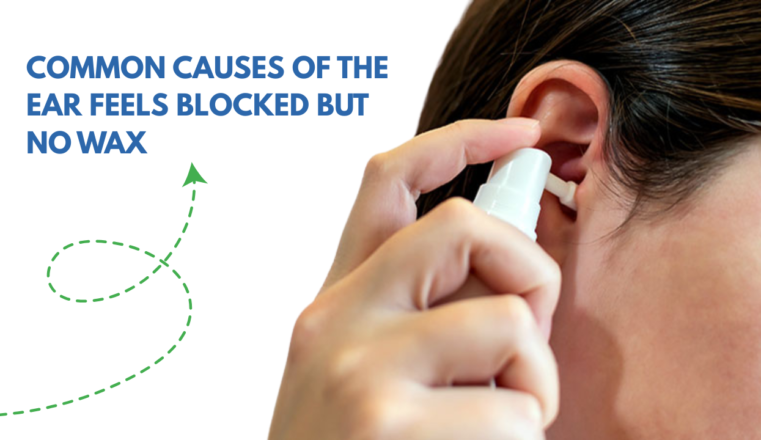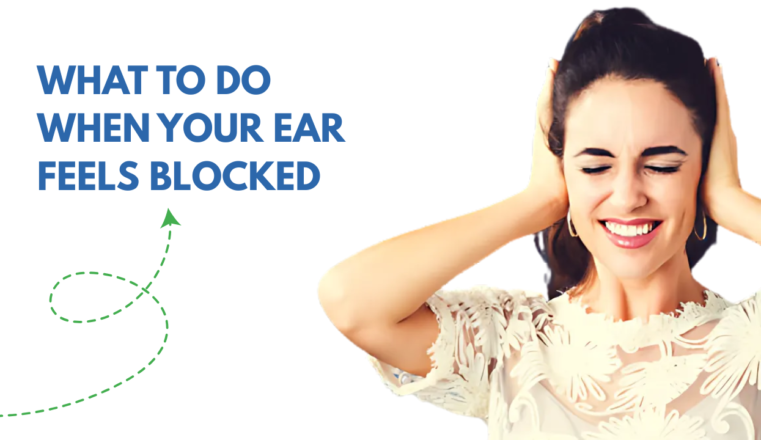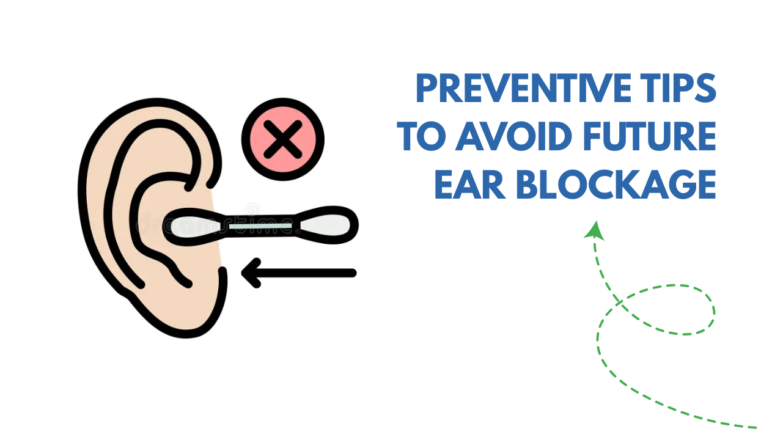- Your cart is empty
- Continue Shopping
Ear Feels Blocked But No Wax? 10 Causes and Solutions

Have you ever felt that your ear canal is blocked but there’s nothing in your ear? It’s not unusual. When your ear feels blocked but no wax is present, it’s actually quite frequent and may feel uneasy, disorienting, or even uncomfortable. People panic, believing that it is the worst. However, the majority of times there are rational and treatable causes for this feeling. This article examines possibilities of the causes, symptoms and treatment options for your ear feels plugged however there isn’t any wax.
Common Causes of the ear feels blocked but no wax

1. Eustachian Tube Dysfunction (ETD)
The eustachian tube connects your middle ear with the ear’s back which helps to balance the air pressure. If they are inflamed or plugged (due to cold, allergies or sinus problems) it is possible that your ear will feel blocked despite being free of wax.
2. Sinus Pressure or Infections
Sinus congestion due to the flu, cold, or infection can cause pressure inside the head, which can affect the ears. This imbalance in pressure can lead to the ears to become distorted or even a blockage sensation.
3. Fluid in the Middle Ear
Otitis media that is accompanied by effusion, or the entrapment of fluid behind the eardrum can result in a blocked or full sensation. The condition is usually seen following an infection or after allergic flare-ups.
4. Barotrauma from Altitude Changes
Scuba diving or driving through mountains? Extreme altitude fluctuations can mess with the pressure in your ear and make your ears feel full or blocked.
5. Allergies and Rhinitis
The effects of seasonal or environmental allergies are irritation of the nasal passages which may extend to ears. The post-nasal drip can also increase pressure on the eustachian tube.
6. TMJ Disorders (Jaw Issues)
The jaw joint lies near your canal for your ear. Any tension or misalignment here (like grinding your teeth or clenching them) could cause discomfort or a feeling of fullness in your ear.
7. Hormonal Changes Like Pregnancy
Women who are pregnant may experience an increase in pressure in the ear due to hormone and body fluid retention. changes. The problem usually disappears after childbirth.
8. Swimmer’s Ear (Otitis Externa)
Even without water, wax or a bacterial infection within the ear’s exterior can cause swelling and blockage sensations. This is often the result of bathing or excessive cleaning.
9. Hearing Loss or Nerve Damage
Sometimes, a blocked ear sensation could be caused by auditory nerve disorders, for example, sudden or age-related hearing loss. The condition doesn’t always manifest with discomfort or wax accumulation.
10. Rare Causes (Tumors or Neuromas)
Though rare, benign tumors such as acoustic neuroma may affect the auditory nerves, creating a constant sense of fullness and balance problems or loss of hearing.
Symptoms That May Accompany a Blocked Ear
Even if there’s no earwax and your ear feels blocked but no wax is visible, it may be accompanied by various signs. Early awareness helps with proper assessment and therapy.
Fullness or Pressure
The most frequent sensation you get is the feeling that your ear feels “full” or under pressure like what you may feel when traveling by air. It is usually due to inflammation, fluid or poor pressure control within the ear as a result of the eustachian or sinus tube malfunction.
Ringing (Tinnitus)
An ear that is blocked can cause tinnitus, an ongoing buzzing, ringing or humming sound from either or both ears. This could be related in part to nerve-related sensitivity, the buildup of fluid or pressure imbalance in the ear. In spite of wax being absent, problems in the ear can cause this condition.
Dizziness or Balance Issues
The ear’s lining is essential to maintaining equilibrium. If your ear becomes restricted, especially because of an infection or fluid it can be shaky or dizzy. In the most severe instances vertigo — which is an unsteady sensation may occur, signalling an inner ear issue.
What to Do When Your Ear Feels Blocked

If your ear feels blocked but no wax is present, try exploring a few simple and safe home remedies before rushing to see a doctor, especially if there’s no severe discomfort or fever.
Simple At-Home Remedies
- Yawning or chewing gum: The actions of chewing gum or yawning trigger the muscles that surround the eustachian tube, assisting to open them and ease tension.
- Swallowing repeatedly: water or sucking on sweets that are hard can help to equalize pressure in the ear naturally.
- Warm compress: Gently apply a towel on the ear. This will help ease the pain and help to drain in the event that fluid has accumulated within the.
When to Try Steam or Decongestants
- Steam inhalation: when you inhale steam from an ice cube or take a hot shower. It aids in loosening the mucus that is trapped inside the nose passages and enhances the flow of air through the eustachian tubes.
- Nasal sprays or decongestant tablets: are only used when allergies or sinus pressure are present. Always adhere to the dosage guidelines. They can reduce inflammation that could cause your ear to be blocked.
Safe Ear Exercises and Movements
- Valsalva maneuver: The Valsalva technique is to close your mouth, squeeze your nostrils shut then slowly try blowing air by blowing your nose. It could pop your ears and help balance your internal pressure. Be gentle to avoid injury.
- Toynbee maneuver: Swallow while keeping your nose closed it’s a safe and simple method of opening tube obstructions.
Avoid head movements that are rapid If you’re feeling dizzy, instead, lie or sit still until you feel better.
When to See a Doctor
Although home remedies are able to resolve the majority of ear obstructions certain situations require expert assistance.
If Symptoms Last More Than a Week
If the sensation is blocked for more than 7-10 days even after at-home treatment, it’s the time to consult a GP. The blockage that persists for a long time could be a sign of an infection, fluid buildup or inner ear disorders that require medical attention or examination.
If Pain or Hearing Loss Increases
Hearing loss that is sudden or becoming worse extreme pain drainage from the ear, or a swollen oesophagus indicator. These may indicate an inner or middle ear infection, ruptured eardrum, or other nerve-related problems. The prompt treatment is essential to avoid permanent damage.
Preventive Tips to Avoid Future Ear Blockage

To keep your ears healthy, it requires awareness and routine. Here’s how to avoid that feeling when your ear feels blocked but no wax is present:
- Manage allergies and sinus issues early: by using antihistamines or prescribed allergy medications during seasons of flare-ups.
- Avoid inserting objects: such as cotton buds, hairpins or even fingers could cause irritation to the ear canal and increase inflammation.
- Dry your ears after swimming or showering: Turn your head back to let the water drain away and prevent water build-up.
- Chew gum or swallow during flights: This helps balance the pressure and stops barotrauma from occurring.
- Maintain jaw health: When you grind your teeth, or notice jaw stiffness, see your dentist or therapist to reduce TMJ stress.
FAQs
A1: Your ear could feel blocked due to pressure imbalances and fluids in the middle of the ear, or sinus congestion. Even without inflammation, earwax or eustachian tube problems could cause this sensation. It’s usually short-lived and is treatable.
A2: Try swallowing or yawning, inhaling steam or the Valsalva maneuver to balance pressure. Nasal sprays or decongestants may aid if sinus problems are present. Do not insert any product in the ear canal.
A3: Yes, allergies can lead to inflammation of the nasal passages as well as the eustachian tubes. This leads to pressure buildup and a blocked ear feeling especially in the time of pollen heavy season. The early treatment of allergies can help prevent this.
A4: If the pain lasts for more than seven to ten days you should see a doctor. A prolonged blockage could indicate an infection, fluid accumulation, or nerve problems. A timely diagnosis is helpful in avoiding complications.
A5: A blocked ear that doesn’t hurt is not usually a serious issue and can be attributed to changes in fluid or pressure. If it persists for longer or causes hearing loss or hearing, it’s a good idea to get evaluated. The persistent fullness may be a sign of issues that are underlying.

